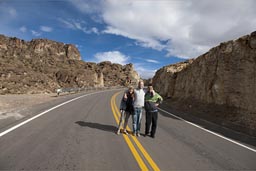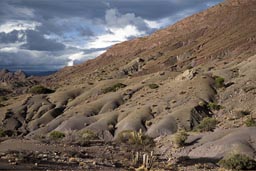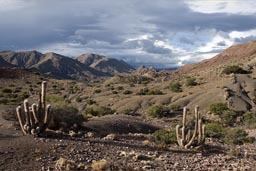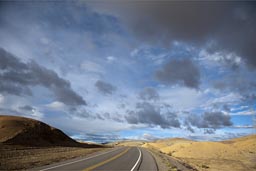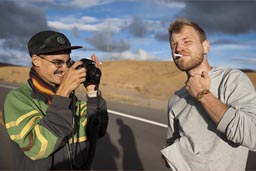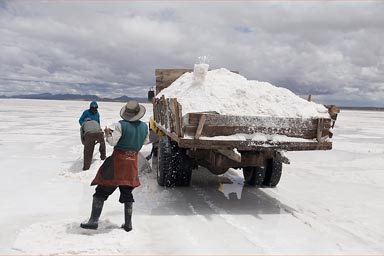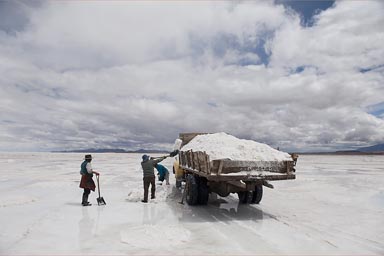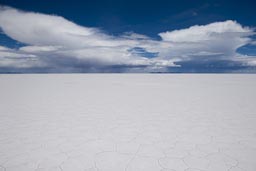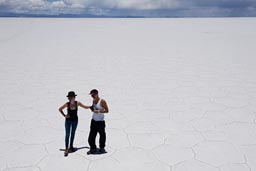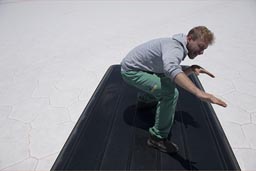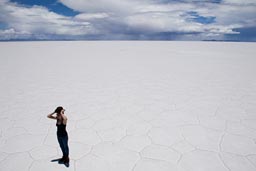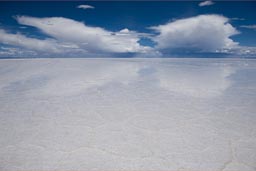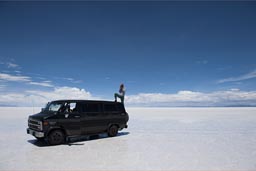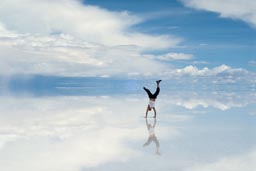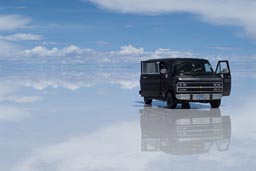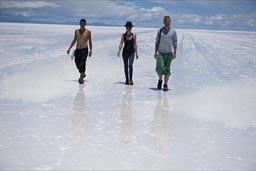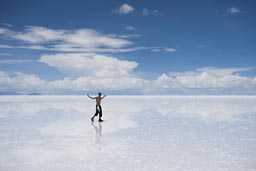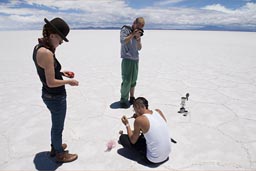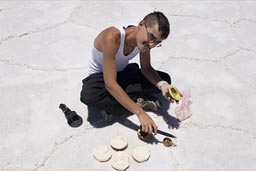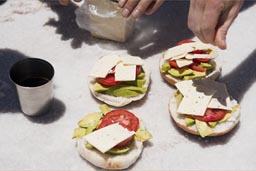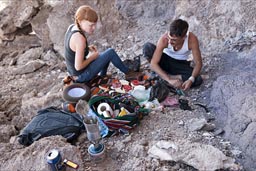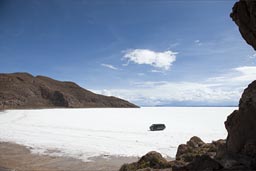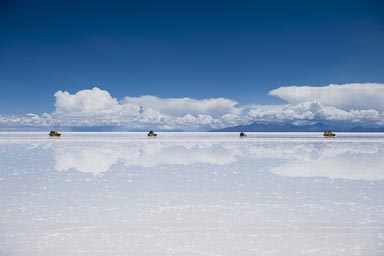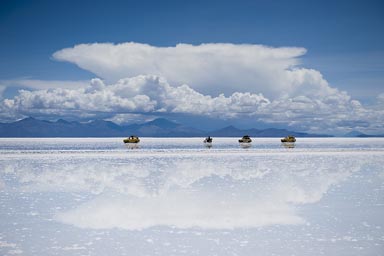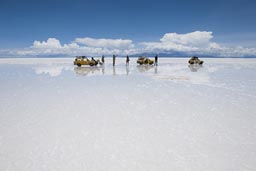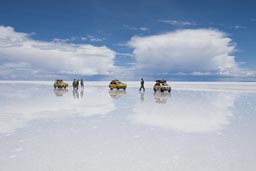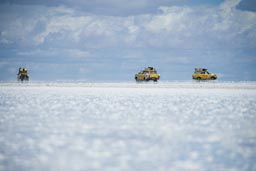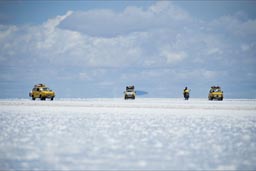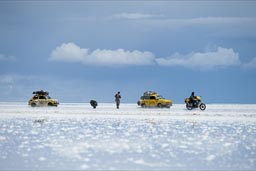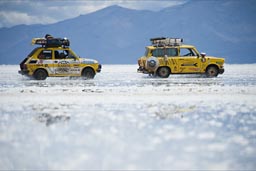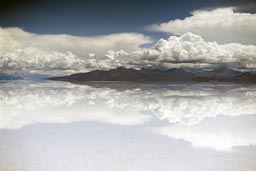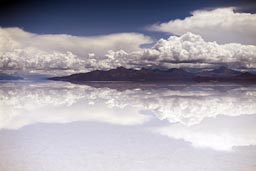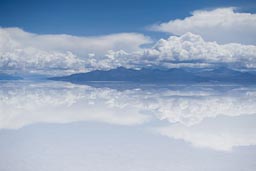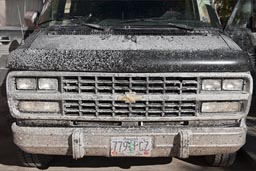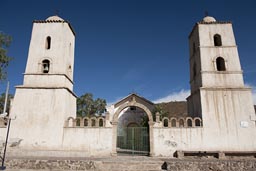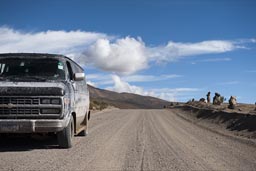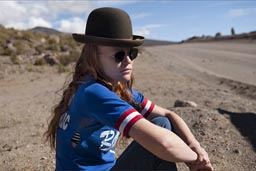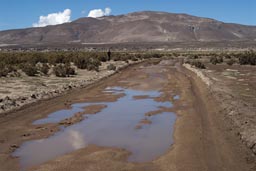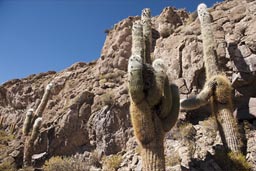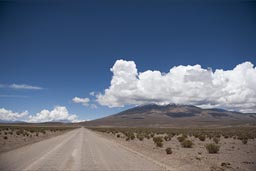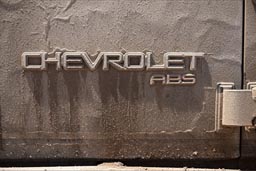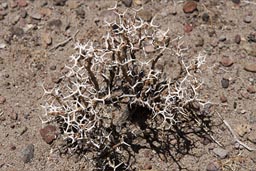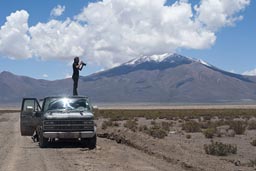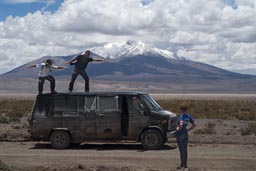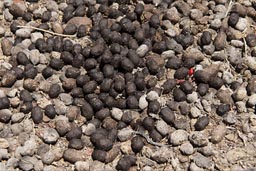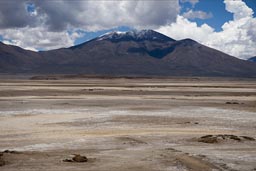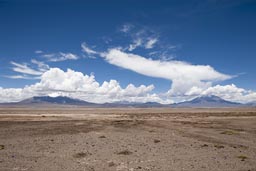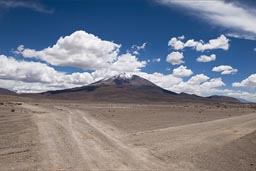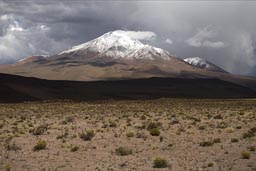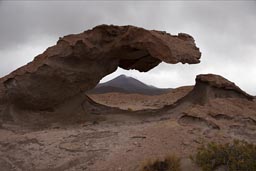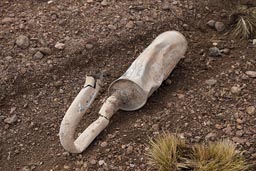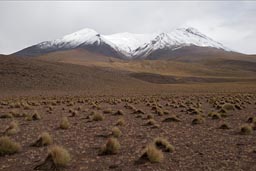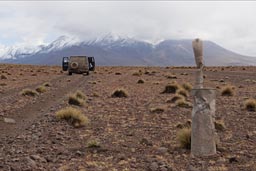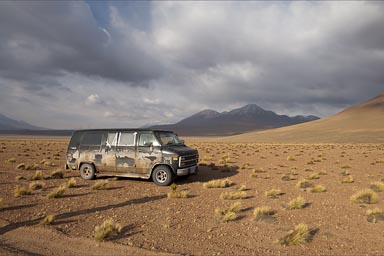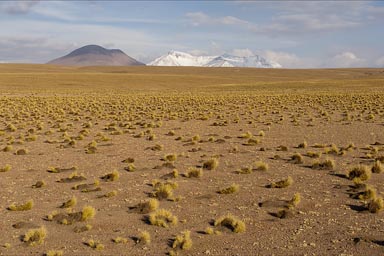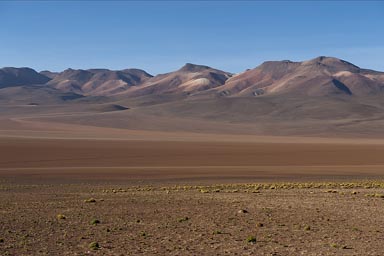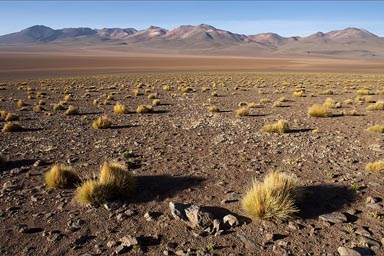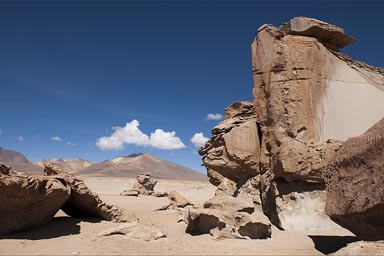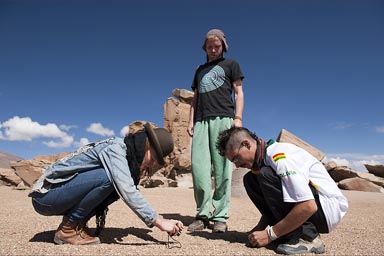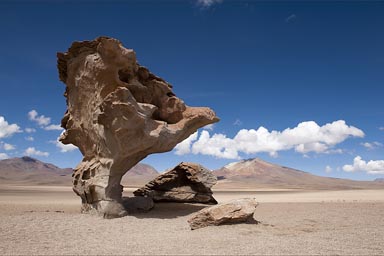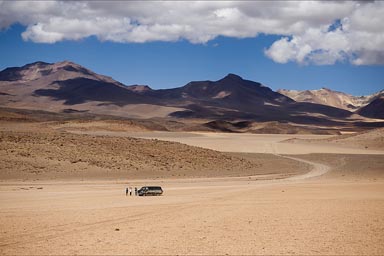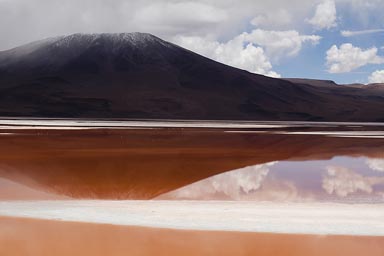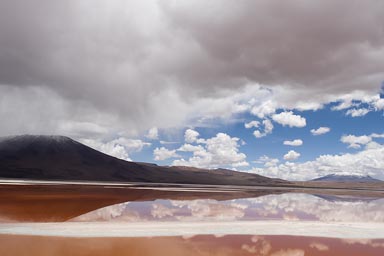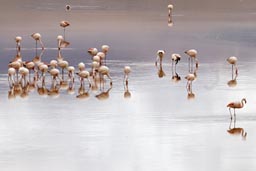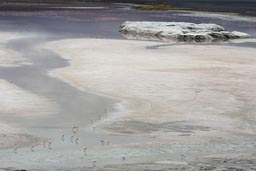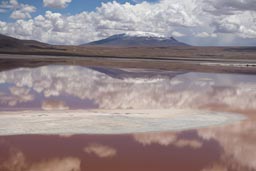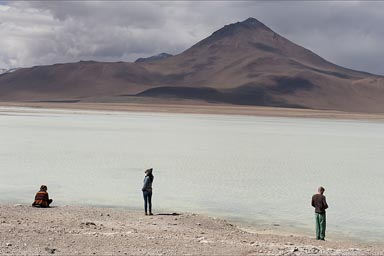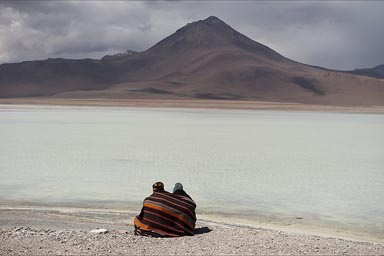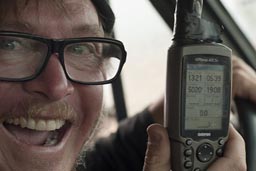www.thisfabtrek.com > journey > south-america > bolivia > 20121208-uyuni
Bolivia adventure, lagoons and salt flats, a journey by four friends.
Download GPS (KML) track/waypoints.
Text courtesy by Catherine Ross.
Cruising down the pavement from the Bolivian border as it drops straight down into northern Chile's Atacama basin, catching glimpses of the emergency runaway ramps every 700 meters as they blur past, feels much like a free fall. Downshifting to save the already smoking brakes, the car is silent, encapsulated by the fleeting wonder of this life. It is in this moment that I attempt to process the intense four day ascent through the many landscapes of the Bolivian altiplano with Manfred, Jean and Flo; replaying various scenes in my mind like a movie, as we descend thousands of meters in elevation toward the end of this story.
But, at this point, there isn't even enough time to understand that it isn't likely I'll have a paralleled experience again.
It all began in Sucre.
I suppose it is fair to tell that it all began at a hostel's bustling communal table in Sucre, Bolivia, amidst the chaotic clanking of tin mugs, filled with red wine and beer, and foreign languages, the smell of many dishes cooking simultaneously. This is how we four met, Jean, Flo, Manfred and I, all within our own journeys. It was at this table that we told our stories. It was here we allowed them to merge.
The plan... well there wasn't one. I guess the general goal was to drive cross the Salar de Uyuni, to navigate our way through the altiplano of Bolivia with its colored lagoons and volcanoes, somehow ending up at the Chilean border. I remember, we stared at Manfred's '94 Chevy van (that he has spent the last two years driving south from Seattle, Washington toward Patagonia) smiling, knots in our stomachs. The chipping black paint and masking tape rolling back along the side windows wailed of adventure. Just the look of the rig told us, get ready. It said, here we go.
The first day was spent traveling southwest from Sucre, Bolivia to Uyuni - the tourist-filled launch pad to the largest salt deposit on the planet. In Uyuni, our four pairs of eyes combed the local market for travel friendly snacks to survive our journey through the wilderness. This would be the last market for us in Bolivia, not lost on Jean, a French chef, who caringly chose the ingredients that would give birth to the 'Salare Sandwich' - which we happily ate at least three times daily for the entirety of the trek. (It surprised us to find such amazing products in this landlocked country, where the Earth is said to give the people very little. To witness the incredible difficulty of farming on the dry, steep slopes of the Andes with nothing more than a hoe or shovel - at best a beast to drag the plow - allows one to realize the miracle and skill behind the rainbow of fruit and flowers at every Bolivian market). We stopped on our way back to the van to enjoy a traditional soup for breakfast, where we were awed by Manfred's world experience as he quickly shoots down the host's attempt to overcharge us. Don't even let yourself be mistreated, he told us.
Second time over the Uyuni Salare.
Off road action in the Chevy van, Uyuni Part 2 and the high altiplano lagunas.
Soaking wet from the beginning of the rain season, the Salare de Uyuni was glistening when we reached it. We watched as an indigenous family heaved the slush by the shovel full into their five-ton camionetta, our jaws falling to learn they are paid only four Bolivian pesos (about $0.50USD) per fifty kilos of (this time wet) salt they collect! This would prove a stark contrast from the Islas found toward the center of the salare, where, through tourism, the land provides well for the Bolivians. People come from everywhere, with good reason, to see this desert of salt. For the ancient cacti of the Islas, they come, and for the bubbling thermal pools and colored lakes, the flamingos and sunrises...
Reminiscent of snow, bright and glowing in the hot sun at over 3,700 meters asl and stretching over 200kms across, the salt deposit is a surreal landscape. We jumped out, giggling like children, dipping our fingers in the salt just to taste it. The recent rain caused a rare phenomenon, producing a mirror-effect. The earth becomes the blue vastness of the sky; the sea appears in the whiteness of the salt. Every cloud fluffed around us like we had made it to Heaven. We pretended to be sailors or pirates, navigating our ship into the open blue: First Mate, Florian, grabbing the stern while Captain Manfred hung wildly out the driver side door, snapping photos and looking for land ahead.
Czeck South America Trabant challenge.
As we proceeded into the expanse of this mineral desert we noticed a bit of commotion. Stopping we encountered a group of Czech men, documenting their drive through Latin America in Trabants, with an incredible distance to cover in the few short weeks they had allotted to do so. Yes, Trabants, the iconic vehicles of the Soviet Area Eastern Block! They repeated their mission to each eager ear, as if they were under spotlight, but afforded our interest little time. The Trabants in bright yellow, covered in sponsors' stickers and logos, the latest technology, hanging off each cameraman's neck, they appeared more to be on a Dakar like race than a journey.
When alongside a highly organized, strictly scheduled operation as such, our troop surely seemed quite suspect. We were two Austrians (one banker turned traveling photographer, the other, a coffee-loving computer genius), a French chef, an American writer and a three-ton two-wheel drive Chevy van - fearlessly traversing the daunting, roadless wilderness of the Andes, brought together only by chance and held together by a love of discovery. No big cameras. No sponsors. No time frame. Just open eyes and hearts, a few photos and stories and beers and whiskey and rum shared at the end of each day, getting to know one another while living something we would never forget.
Needless to say, we got some cock-headed stares.
The rains had erased any trace of a road on the salt flat and we felt a growing sense of isolation as the Czech group asked us to move the van out of their shoot - filming themselves, driving into whiteness of the salare, then packing up their equipment and turning back to Uyuni. Their small cars would be no match for the terrain to come.
The most common and only advertised way across the area are guided tours. For some two-hundred USD a Bolivian guide will take a group of tourists from Uyuni as far as the Chilean border, stopping in-frequently, so you snap a photo or two. It is actually quite discouraged to find your own way, and though I am certain this is partially for the good business of the tours, the route would prove itself again and again, reminding us why only 4x4 vehicles dare cross it. This altiplano is, after all, the highest and wildest plateau area on Earth (outside of Tibet).
Off the salt into the mud.
Off the salare that night we sought refuge in Colcha 'K'; a small and charming, untouched Bolivian village, where we were warmly welcomed by the hospitable locals. Moments such as these are worth entire trips. Discovering people and places by circumstance or by chance, rather than by mapped-out hot spots and itineraries, where, not over run by tourism, the communities' interest matches the traveler's.
The following morning, the scene had transformed. We found ourselves in a rocky high mountain desert, surrounded on all sides by volcanoes with cloud and snow covered peaks. The dirt road carrying us away from the salare became a mere suggestion and we were forced to forge our own path. The rains had turned the normally dry ground into a quicksand of mud and left us no choice but to gun it. Full speed or else! Through the mud and rocks and pools and dips, we flew, Manfred smiling and repeatedly shouting the 'f' word as we slipped off the road and only just made it back, but he clearly enjoyed the adrenaline. Us? We screamed too and gripped our seats. The condition of the roads we sped through were hallucinating. That we managed not to get stranded in the middle of the Andes during the rainy season with only two-wheel drive, however, is beyond reason.
The most terrifying fun I ever had in a car.
Fuel the issue!?
But we also had to worry about fuel.
In Bolivia, foreigners are charged a higher price for gas, sometimes without the right to purchase it at all. Plus, there are no stations around when you are in the middle of the nowhere, and this is where we were. Then, after the day of driving the desert and mud, we crossed a tour, by chance, the guide informing us of the distance we faced, in any direction, to reach anything or anyone. After the crossing I can say he was just the typical guide talking, lying about distances, not necessary difficulties, and also he probably never crossed into Chile himself, he did not know the customs offices, 'there is none in the mountains', but there was, as Manfred said he knew.
We'd need twice the amount of fuel than we have in our tank, he said.
We'd never make it, he told us.
Guides never know, said Manfred, but this one even made him worry.
Up into the mountains, the high altiplano, roadless.
It's about 10kms later that solidarity, adventure and luck landed us in a rogue gas deal. A Bolivian truck driver, bringing gas into Chile, sold us 60 liters of gasoline, his entire family in the cab of the truck, eating ice cream. After a discreet exchange we were aided by some other local workers to get the gas into the Chevy's belly, by aid of a hose.
So, we had certainly enough gas then. We realized how lucky we were, even stopping shortly down the road for a three-minute dance party. We were feeling good.
Until we lost the muffler, 3 hours later realizing the guide did not lie about the 'roadless' conditions. But the Chevy, soldiered on, and as somebody said, one day, like a cowboy, he'll die standing up in his boots.
Imagine the sun falling over a vast desert, surrounded by the purple mountain peaks, at over 4,500m in elevation. The are no roads to follow, only hundreds of tracks etched into the red dirt by 4x4s, side by side in a most harmonious design, like crop circles. This was our view as we made only fifteen km of progress in one hour, grinding through the terrible power and beauty of the land. The van was almost smoking and us, well, we were all exhausted and shaken by the last few grueling hours of route. The moon was taking the power of the sun, so we searched for a place to pass the night. We found a hotel but so dominated is the area by private tour companies, we, as vagabonds, were turned away.
Turned away. In the middle of nowhere. In one of the wildest places on the planet. Night falling...
But, Oh! Lady Luck saved us (again) that night, when looking for a place to camp we happened upon the only other refuge in the area, Tayka hotel. After dinner we slept like babies, on 4,500m asl.
Rock structures on the Bolivian altiplano.
The final day began as most: Manfred, well rested and beaming, singing along to an oldie with his smiling face stuck far out the window. It is such a powerful and beautiful feeling to observe someone who loves what he does. The ride was bumpy again and the rest of us were all literally bouncing in our seats. We reached the beautiful ancient rock formations and the famous, Arbol de Piedra, to realize that our oversleeping has once again caused Manfred to miss the ideal morning light in which to photograph. (Every evening he would ask us what time we would be up the next morning. Dawn, I said, every evening. He would smile warmly and chuckle a moment, all of us knowing we would never be awake before nine). So, instead of document the breathtaking rock formations, we just stared at them.
Lagunas Colorada and Verde.
After a coffee break and back in the van, my heart swelled and pounded like a machine at first sight of Laguna Colorada. It must be the most beautiful place on the planet. Named the 'colored lake' for the pink and red and maroon hues of the water, one could be easily fooled that the lagoon was a painting. Its background is held by an impressive volcano, partially cloaked by thin, misty clouds. Flamingos feed and chatter and flock about by the hundreds. Mossy, lush green borders of the lake are grazed by guanaco (a type of wild llama) and do all but beckon you to come closer yourself. Colors so beautiful, you want to eat them.
There we sat, in silence, trying hard to memorize that lake, until a storm chased us back into the safety of the Chevy, where we again sat quiet, trying hard not to forget what we'd just seen.
We continued to Laguna Verde, which sits further south, stopping to take in it's glassy colors, savoring the last amazing and precious piece of the altiplano.
Having sought out the other border crossing earlier, somewhere between Lagunas Cororada and Verde, cruising around the nothingness at 5,000m asl, our skulls feeling like deflated balloons, and there was the aduana the guide had known nothing about, and we managed to stamp out the Chevy's papers. Jean, our French chef, had overstayed his tourist visa and should have been heavily fined, yet wasn't. South of Laguna Verde we crossed free and clear. A common experience in Bolivia: being reminded that things are rarely what they seem.
Just like an unlikely union of four travelers, traversing the unforgiving and beyond beautiful high mountain deserts of the Andes, resulting in great friendships, ending as a great story.
www.thisfabtrek.com > journey > south-america > bolivia > 20121208-uyuni

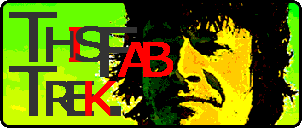
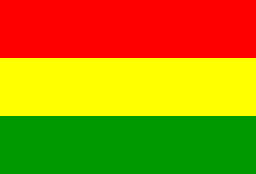
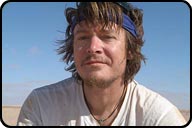
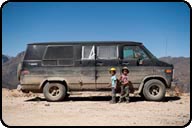


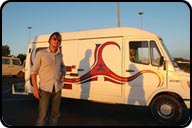
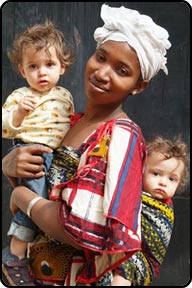
 contains Festival/Fiesta/Art photography.
contains Festival/Fiesta/Art photography.
